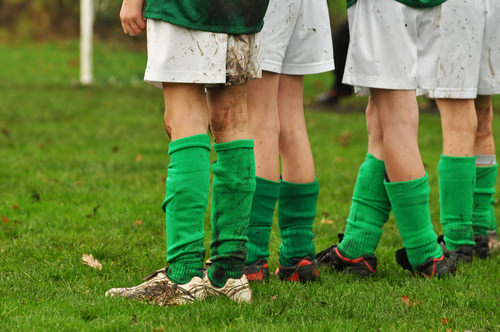
Most coaches will work with youth players at some point in their career. Youth coaches will recognise that there are physical differences between the players in regards to their height. When players are going through their mini growth spurt these differences can be considerable. The first question for the coach is, do you acknowledge the fact that there are physical differences and the second question is, what are you going to do about it? The easiest thing to do is to divide the group into two teams and just let them play. But are you doing yourself a favour here?
Some children start puberty earlier then others and these are called, early maturers. Other children start puberty later and are called, late maturers. This is a fact that no coach can escape from and therefore has to deal with one way or another. Many youth coaches do not have the luxury of being able to divide their U17 age group into two teams, mainly because they do not have enough players to do so. It also means that you can’t divide them by their biological age. Simply put, it means that this is what it is. How are you going to deal with this situation when talking about planning the individual workload per player? Or are you going to ignore this completely?
If you are lucky you will at least have a squad made up from players born in the same year. That being said, it can still be the case that one player is born on the 2nd of January and another player born on the 29th of December. This means a difference of almost one year, which again can mean a big physical difference. When a player has a mini growth spurt bones grow faster then the muscles. There is now more tension on the muscles which can cause tendon problems. What you often see is that these players temporarily have poorer coordination, which makes them more susceptible for injuries.
When players have gone through a mini growth spurt and coaches recognise that they have grown (when returning from holiday for example), they should adjust the workload of these players. This could mean a lower training load in both training and game minutes. When most players in your U17 squad are early maturers, the coach often takes them as the reference for the planning of the workload. But what about the few smaller ones, the late maturers? A normal football tactical session is often more then enough work for a smaller player, not to mention a football conditioning session. Let’s say that you train three times per week and one session is a football conditioning session. What you could do is allow the smaller players to drop this football conditioning session from their week. This is to ensure that you still can work on the communication in the two other sessions that week. If you only have two sessions per week it is of course not helpful if you are to drop this to one session for some players. When having a group with physical differences between players the workload can be adjusted by; 1) the amount of sessions, 2) the duration of the sessions, 3) the content of the sessions, 4) work/rest ratio within the exercises and 5) game minutes.
Challenges within a squad are many. You could have the same amount of early and late maturers. You can have a lot more of one or a lot less of the other. It is the coaches job to ensure that the smaller players cope, so that every player has a fair chance to develop his football ability. You as a coach are responsible when injuries occur during your training. If you only have 18 players you definitely need all of them attending, every session and game.
The parents expectations of a football club, when hiring an U17 coach, should be that they know the coach has the knowledge and experience to provide a safe learning environment. So in an ideal world every coach should be specialised within a certain age group, but as we all know…
Thanks for sharing.
Whats up very cool blog!! Man .. Excellent .. Wonderful .. I’ll bookmark your blog and take the feeds additionallyI am glad to search out a lot of useful info right here in the put up, we’d like work out more techniques in this regard, thank you for sharing. . . . . .
LikeLike
you will have a terrific weblog here! would you wish to make some invite posts on my weblog?
LikeLike
Please contact me via my contact info about this.
LikeLike
I have read several good stuff here. Certainly worth bookmarking for revisiting. I wonder how much effort you put to make such a excellent informative website.
LikeLike
Not only tall players are early developers. What you look more for is muscle growth! Your parents might be small and you will be small but you can still develop early..
LikeLike
Hello! I simply want to give an enormous thumbs up for the good information you could have right here on this post. I will be coming back to your blog for extra soon.
LikeLike